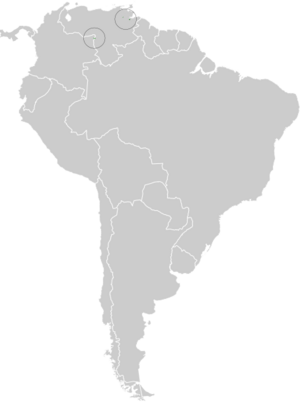Río Orinoco spinetail facts for kids
Quick facts for kids Rio Orinoco spinetail |
|
|---|---|
 |
|
| Conservation status | |
| Scientific classification | |
| Genus: |
Synallaxis
|
| Species: |
beverlyae
|
 |
|
The Rio Orinoco spinetail, also called the Orinoco spinetail, is a special type of bird found mainly in Venezuela and maybe in Colombia. Its scientific name is Synallaxis beverlyae. This bird is considered Near Threatened, which means it could become endangered in the future if we don't protect it. It belongs to the ovenbird family called Furnariidae.
Contents
What is the Rio Orinoco Spinetail?
How was this bird discovered?
The Rio Orinoco spinetail was first described in 2009. Scientists quickly agreed it was a new species. It's related to other birds in the Synallaxis group, like the dark-breasted spinetail. This bird is monotypic, meaning it's the only species in its specific group.
What does the Rio Orinoco Spinetail look like?
This bird is about 13 to 16 centimeters (5 to 6 inches) long. It weighs between 11.5 and 14 grams (about half an ounce). Both male and female birds look the same.
They have a whitish stripe above their eye and another whitish line below it. Their face and forehead are gray. The top of their head is a reddish-orange color, and the back of their neck is smoky-gray. Their back, rump, and tail feathers are light grayish-brown.
Their wings have cinnamon-reddish feathers, with some olive-brown ones too. Their flight feathers are olive-brown. The underside of their wings is grayer than the top. Their tail is brownish with a reddish tint, and the feathers have pointed tips.
Their chin and throat are whitish. Their upper chest is pale gray with a smoky-brown tint. Their lower chest and belly are dull white with a pale clay color. Their sides are pale clay, and the feathers under their tail are pale beige.
Their eyes can be light grayish or pale brownish-yellow. Their beak is horn-gray, lighter on the bottom half. Their legs and feet are also horn-gray.
Where does the Rio Orinoco Spinetail live?
The Rio Orinoco spinetail is mostly found along the main channel of the Orinoco River. This includes the river's delta and middle parts in Venezuela. Scientists think it might live along the entire river, but they haven't explored everywhere yet.
Some people believe it also lives in nearby parts of Colombia. However, these sightings haven't been officially proven. Because of this, some bird groups don't officially recognize it as living in Colombia.
What kind of places does it like?
This bird lives in bushy areas on river islands. It also lives on the river banks near these islands. These areas often get flooded when the river water is high.
How does the Rio Orinoco Spinetail behave?
Does it move around?
Scientists believe the Rio Orinoco spinetail stays in the same area all year round. It does not migrate.
What does it eat?
We don't know much about what this bird eats or how it finds food. It's thought to eat arthropods, which are small creatures like insects and spiders. It probably picks them off small branches and leaves, just like other birds in its group. It usually stays hidden in thick plants and looks for food from the ground up to about 3 meters (10 feet) high.
Reproduction and life cycle
Scientists don't know anything about how the Rio Orinoco spinetail builds nests or raises its young.
What sounds does it make?
There are not many recordings of the Rio Orinoco spinetail's calls. Its main call is a series of 6 to 9 fast, clear notes. The first note is usually louder. It also makes a longer, faster series of notes and sometimes a single loud note.
Is the Rio Orinoco Spinetail in danger?
The IUCN (a group that tracks endangered species) has listed the Rio Orinoco spinetail as "Near Threatened." This means it's not in immediate danger, but it could be in the future.
This bird lives in a very small area, and we don't know exactly how many there are. However, its population seems to be stable for now. There are no big threats right away. But its home might be affected by farming on river islands during dry seasons. Also, more tourists visiting sandy islands could be a problem in the future.


